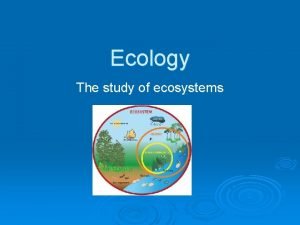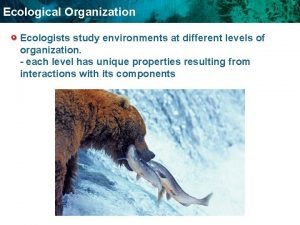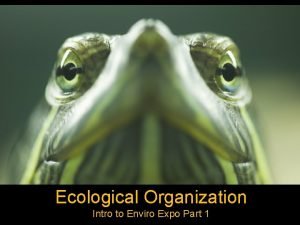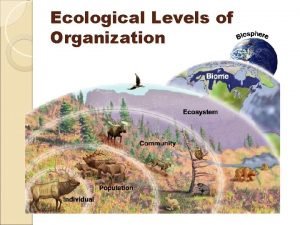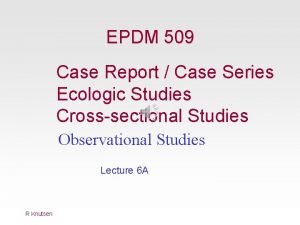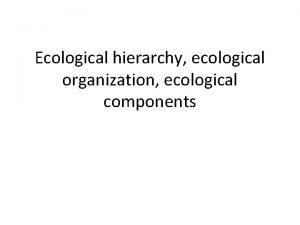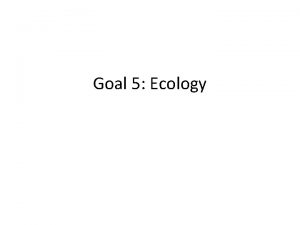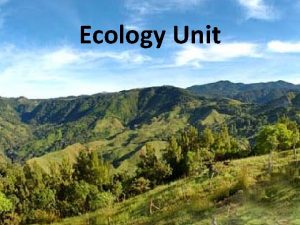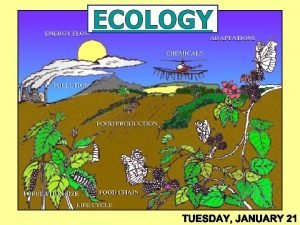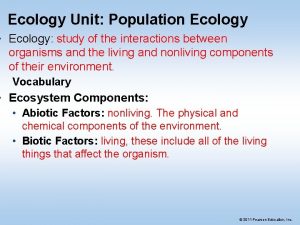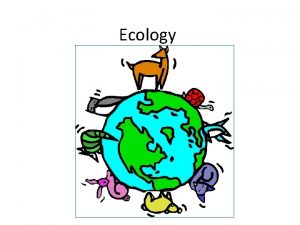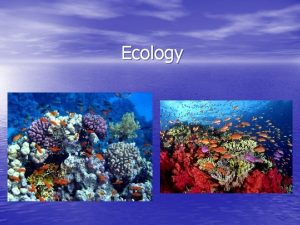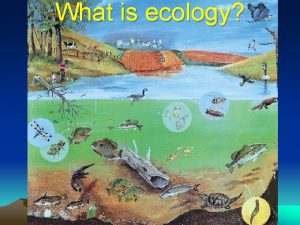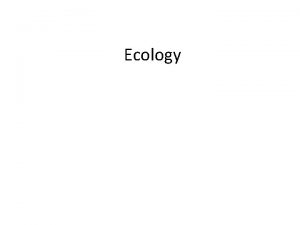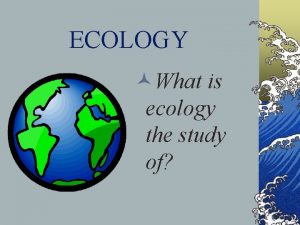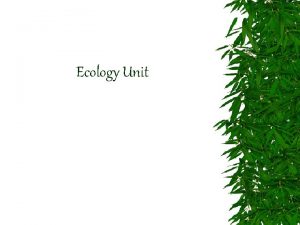ECOLOGICAL ORGANIZATION Ecological Organization Ecology is the study































- Slides: 31

ECOLOGICAL ORGANIZATION

Ecological Organization • Ecology is the study of the interactions of organisms with one another and their physical environment.

Ecological Organization • Every organism has a habitat (where it lives) and a niche (its role or job) in the ecosystem.

Ecological Organization • The interactions of the organisms may be studied as populations, communities, ecosystems or the entire biosphere.

Biotic vs Abiotic • Biotic Factors: Living (or once living) aka. organic • Abiotic Factors: nonliving

Ecosystem Organization • Organism is a single living thing.

Remember species? Species - organisms that can breed with one another and produce viable, fertile offspring.

Ecological Organization • Population is the number of individuals of the same species in the same place at the same time.

Ecological Organization • Community is all of the different populations living in the same area at same time.

Ecological Organization • Ecosystem is all of the communities (biotic) and all of the physical factors (abiotic) in an area.

Ecological Organization • Biomes are ecosystems that span a large area and have characteristic biotic and abiotic factors.

Ecosystem Organization • Biosphere is all of the areas on earth where organisms live.

1. A group of animals that live in the same area and can interbreed is called a (n) ___________ 2. The study of organisms and their interactions with the environment is known as ______________ 3. A large area that has a particular climate and distinct plants and animals is called a ______________ 4. All of the different populations living in an area (plants, rabbits, coyotes. . . ) is called the _____________ 5. An ecosystem includes all the living and ______ factors in an area. 6. The portion of the planet that can sustain life is the ____ 7. Animals that can interbreed are called a(n) ________

The table lists four groups of factors found in a particular ecosystem. Which group consists of only abiotic factors? F Group 1 G Group 2 H Group 3 J Group 4

Community Interactions Competition Symbiosis Predation

Competition Organisms of the same or different species attempt to use the same ecological resource (food, water, space) in the same place at the same time E lk Herd Bison Moose

Competition Occurs when two organisms want the same thing (not good for anybody) Tiger Swallowtail butterfly Two different butterfly species feeding on the same flowers Blue Butterfly

Symbiosis Any relationship in which two different species live closely together is called symbiosis (“living together”) § Mutualism § Commensalism § Parasitism

Mutualism Both organisms benefit Bee on Purple Anemone Examples: § Flowers and insects § Ants and aphids Ant and Aphid

Mutualism Lichen Algae and fungus living together

Mutualism The Chital and the Tree-pie

Commensalism One member of the association benefits and the other is neither helped nor harmed. Examples: § Spanish moss Spanish Moss

Commensalism § Whales & Barnacles Whale Barnacles on Whale

Commensalism § Epiphytes “air plants” Epiphyte in Tree Epiphyte

Parasitism One organisms benefits; one organism is harmed Examples: § Lice, tapeworms, ringworm Female Head Lice

Parasitism Ticks Before After The parasite obtains all or part of its nutritional needs from the other organism, the host. Black Legged Tick Blacklegged Tick: An adult female blacklegged tick, engorged after a blood meal, rests on a leaf.

Parasitism Mistletoe

Predation Interaction in which one organism predator Falcon prey Ground Squirrel captures and feeds on another organism

Predation Grizzlies prey upon salmon Grizzly Bear

Predation Arctic Hare Rabbit and Coyote rabbit coyote

Ultimate Predator? Why is man sometimes called the “Ultimate Predator”?
 Case series
Case series Levels of organization in ecology
Levels of organization in ecology 5 levels of organization ecology
5 levels of organization ecology 6 levels of ecology
6 levels of ecology Biology ecology study guide answer key
Biology ecology study guide answer key Chapter 3, section 1: community ecology answer key
Chapter 3, section 1: community ecology answer key Ecology is the study that helps to preserve
Ecology is the study that helps to preserve Levels of ecological organization
Levels of ecological organization Population community ecosystem biome biosphere
Population community ecosystem biome biosphere Ecological organization
Ecological organization What are the levels of ecological organization
What are the levels of ecological organization Parasitism
Parasitism Freshwater biome biotic factors
Freshwater biome biotic factors Ecological succession case study
Ecological succession case study Ecological study design
Ecological study design Case series example
Case series example Hình ảnh bộ gõ cơ thể búng tay
Hình ảnh bộ gõ cơ thể búng tay Slidetodoc
Slidetodoc Bổ thể
Bổ thể Tỉ lệ cơ thể trẻ em
Tỉ lệ cơ thể trẻ em Chó sói
Chó sói Thang điểm glasgow
Thang điểm glasgow Bài hát chúa yêu trần thế alleluia
Bài hát chúa yêu trần thế alleluia Các môn thể thao bắt đầu bằng tiếng bóng
Các môn thể thao bắt đầu bằng tiếng bóng Thế nào là hệ số cao nhất
Thế nào là hệ số cao nhất Các châu lục và đại dương trên thế giới
Các châu lục và đại dương trên thế giới Công của trọng lực
Công của trọng lực Trời xanh đây là của chúng ta thể thơ
Trời xanh đây là của chúng ta thể thơ Mật thư tọa độ 5x5
Mật thư tọa độ 5x5 Phép trừ bù
Phép trừ bù Phản ứng thế ankan
Phản ứng thế ankan Các châu lục và đại dương trên thế giới
Các châu lục và đại dương trên thế giới

